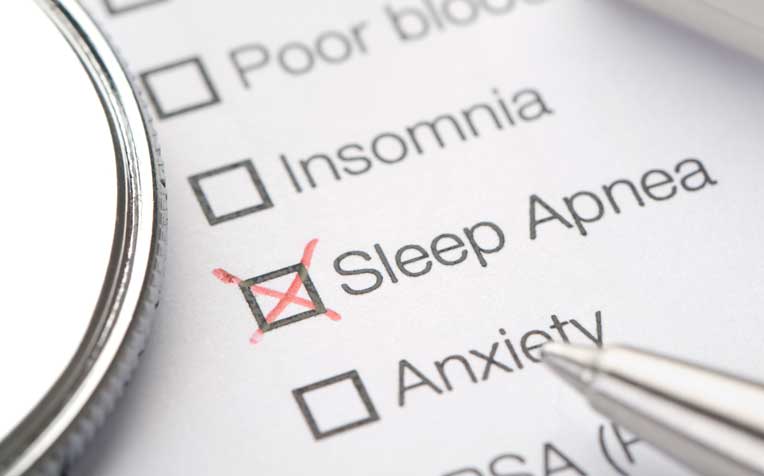
Sleep apnea is a condition where the upper airways are blocked repeatedly during sleep, causing the person to wake up multiple times.
OSA - A common sleep disorder
Obstructive sleep apnoea (OSA) patients can rest easy with a robot-assisted surgical procedure to remove obstructive tissue at the back of the throat.
He has begun to dream in his sleep again. It may not seem like much, but being able to dream means Mr L is starting to sleep normally again.
For more than five years, the 45-year-old rarely slept well or deep enough for dreaming to occur. His sleep was disrupted so many times that, regardless of the number of hours he slept each night, he woke up the next morning feeling tired.

Dr Toh Song Tar (left) and Dr Tay Hin Ngan (middle) use a nasal scope to examine Mr L, who is suffering from obstructive sleep apnea.
Mr L suffers from a disorder known as OSA, short for obstructive sleep apnoea – a condition where the upper airways are blocked repeatedly during sleep, causing the person to wake up many times.
But undergoing a new robot-assisted surgery known as Trans-Oral Robotic Surgery, or TORS, to address obstruction deep in his throat has helped alleviate his symptoms.
Loud snoring, the most common symptom of OSA
The most common symptom of sleep apnoea is loud snoring, although patients also often experience excessive daytime sleepiness, forgetfulness, irritability and an inability to concentrate on work because of frequent disruptions to sleep during the night. Some patients have less obvious symptoms like early morning sore throat or headaches.
“As the condition worsens, the patient often stops breathing during sleep, gasping for air as a result of the airways closing,” said Dr Toh Song Tar, Senior Consultant, Department of Otolaryngology (Ear, Nose and Throat Surgery), Singapore General Hospital (SGH).
When the airways close or are blocked, oxygen levels in the blood can drop, sometimes to dangerous levels. However, sleep apnoea in itself is not a fatal condition because, when the brain senses the lack of oxygen, it wakes the patient from sleep and he begins breathing regularly again.

The airways close or get blocked for many reasons. In Asians, the typically smaller skeletal framework and structures in the throat play an important part in causing the sleep disorder. Children can get the disorder if they have overly large adenoids or tonsils, while the airways of adults often narrow as they put on weight or age.
Depending on where the obstructions are, the patient may be asked to make lifestyle changes such as losing weight or quitting smoking, or may have to use a mask-like device called Continuous Positive Airway Pressure (CPAP) to keep the airways open during sleep.
For tips on how to sleep more comfortably with a CPAP device, read this article.
Patients can also have surgery to remove tissues in the nose or tonsils if the obstruction occurs in those areas, but a more invasive procedure is necessary if the problem lies further down the throat, such as at the base of the tongue.
For Mr L, the CPAP device was too uncomfortable to use. He also went through two earlier operations to open up his nasal passages and widen the area behind the palate. However, he was reluctant to consider a third, more invasive operation, as he was wary of undergoing a procedure which involves cutting the jaw or chin bone in order to pull the tongue forward.
The base of the tongue is a difficult area to reach by conventional surgery and, unless a large incision is made, the surgeon’s view and access are blocked by the jaw and a large part of the tongue. Hence, this usually requires the jaw to be split open.
Robot-assisted surgery to treat OSA
Luckily, for Mr L, a new minimally invasive technique using a robot-assisted surgical system for throat cancers became available in late 2012 for treating sleep apnoea patients.
Robot-assisted surgery doesn’t require large incisions, or even incisions in some cases, to be made in procedures involving hard-to-reach areas. But it still allows surgeons to perform intricate procedures with a high degree of accuracy. This is because the surgeon performs the operation by manipulating surgical instruments mounted on robotic arms which have a range of movements wider than the human hands’. A 3-D high-definition camera also gives the surgeon a clear view of parts of the body not easily seen except when the surgical area is cut wide open, as in conventional surgery.
In the new procedure to treat sleep apnoea, the surgical instruments are inserted through the mouth to perform the operation, so no external incision is made.
The (robot-assisted) system allows this procedure to be performed safely, allowing doctors to reach the most crucial part of the tongue base.
In November 2012, the operation – the region’s first transoral robotic surgery for obstructive sleep apnoea – was performed on Mr L. The technique had been used on three other sleep apnoea and three throat cancer patients.
For patients who choose not to address tongue base obstruction because they do not want bone surgery, they now have this option of a less invasive, safer method of surgery.
Robot-assisted surgery involving small incisions has several advantages over conventional open surgery for patients, such as a shorter time under anaesthesia, which reduces the risk in any procedure especially for older people; less bleeding because of the smaller incisions; and often a shorter hospital stay and recovery period. However, the costs can be substantially higher.
For Mr L, it has made the difference from having airway blockages 46 times an hour to just eight. “I feel much better and fresher, and my mind is able to focus better,” said Mr L.
Ref. G25


















 Get it on Google Play
Get it on Google Play